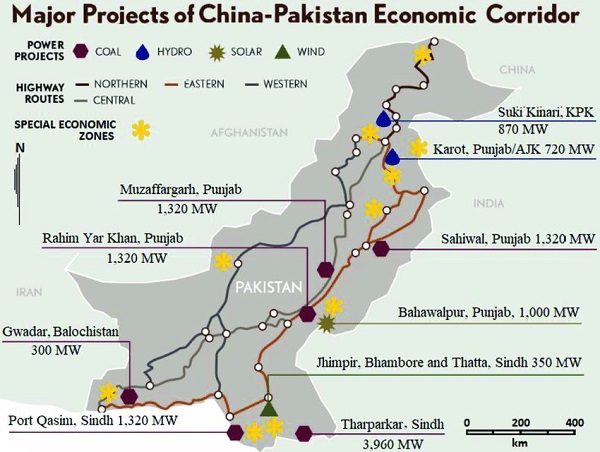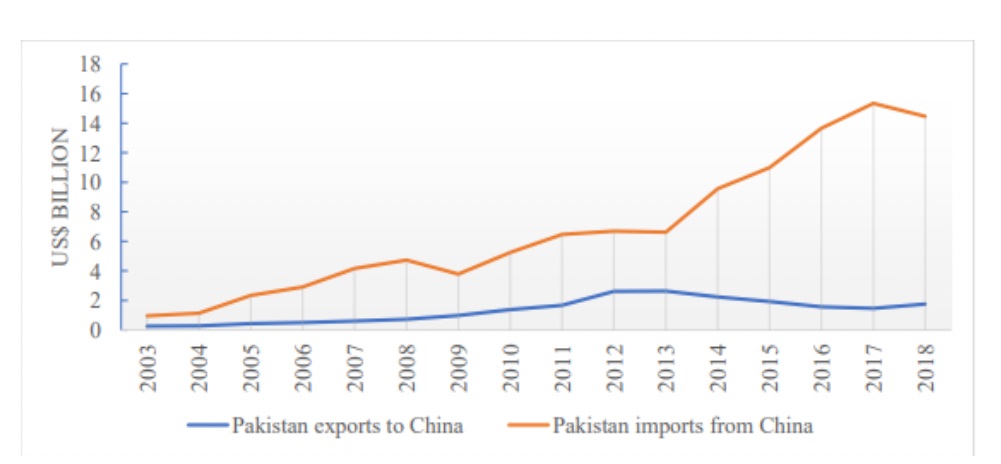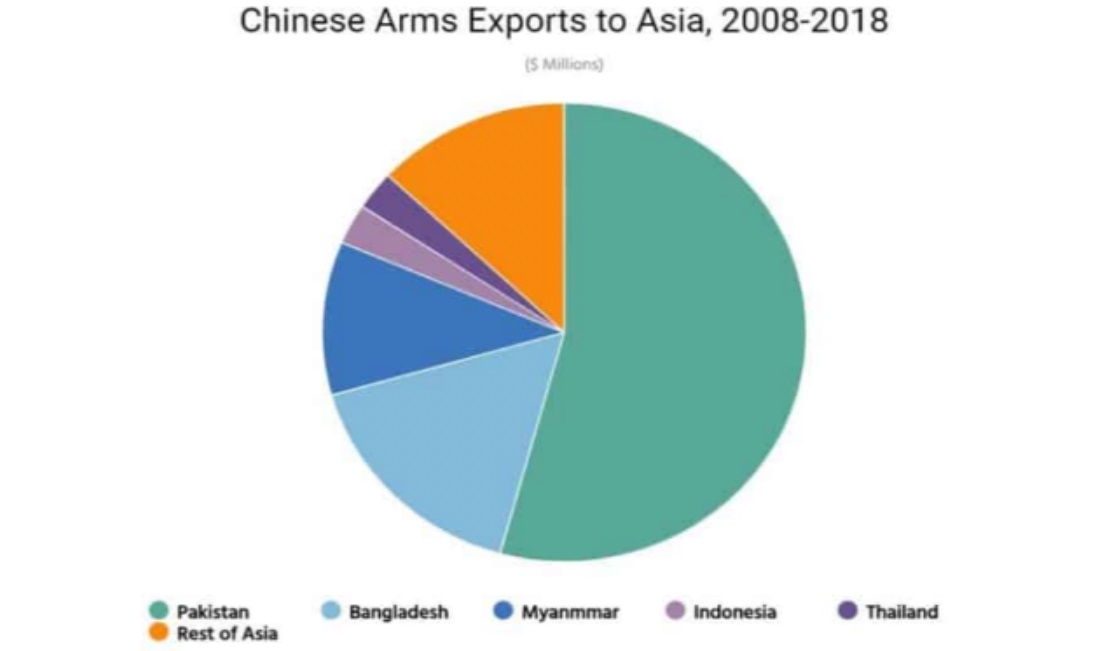By Tazeen Javed
The most important project of the Belt and Road Initiative (BRI) was the creation of the China-Pakistan Economic Corridor (CPEC) in 2013, to connect the port of Gwadar in Pakistan with the Xinjiang province in China.

The entire network of railways, pipelines and highways envisaged by CPEC aims to establish energy supply and trade through economic connectivity, infrastructure development and energy supply projects in Pakistan. The CPEC is perceived as a harbinger of change that has the potential to reconfigure the relationship between Pakistan and China, enhancing cooperation and establishing mutual dependence.
CPEC is a very wide-ranging initiative, it involves investments worth about USD 62 billion in various phases and covers almost all sectors of the Pakistani economy. It has been seen as a great opportunity by Pakistan, as it would enable the economy to witness growth with the reduction of critical infrastructure deficiencies. For China, the CPEC represents an alternative trade route that may ensure the development of direct road connectivity to Africa, Europe and the Middle East, avoiding the South China Sea and the Straits of Malacca. The value of this corridor is not only in economic terms; it has very strategic implications for the region, as it increases China’s influence and presence in South Asia.

Never before has it been possible for two countries to have such an unparalleled level of economic interdependence as CPEC has brought to Pakistan and China. Pakistan has always regarded China as its most trusted friend and this consideration has grown with the inception of CPEC. This project has created a sense of strategic partnership in which Pakistan has benefited from China’s expertise in development and investment, while China has gained an important ally and economic partner in South Asia. The Pakistani economy, closely linked to a lack of foreign direct investment and slow growth, is expected to improve tremendously with the infrastructure that CPEC will initiate.
CPEC’s most important initiatives include the development of the port of Gwadar into a major deep-sea port and the construction of new highways, existing power plants, and special economic zones such as Gwadar; all of which are key to advancing Pakistan’s economic ambitions. China has thus gained new access to some of the major sea routes and energy sources, thus ensuring its economic security against the backdrop of various global geopolitical tensions.
The most significant consequence of CPEC for Pakistan-China relations is the strengthening of political ties and mutual trust. Pakistan has always been a strong supporter of the Belt and Road Initiative and sees the CPEC as a symbol of the country’s commitment to China’s prosperity and development. This partnership has led to deeper cooperation in fields other than infrastructure, including defence, technology and security. Pakistan and China have aligned their policies on the future of CPEC, so much so that both countries have established joint security measures and increased military cooperation against the threats they face. Thousands of security agents have been deployed by Pakistan to protect CPEC from probable threats.
The effects of CPEC on Pakistan’s economy are numerous. This programme has been a great boon for Pakistan’s infrastructural development. Major railway, road and energy projects will help alleviate many chronic problems, such as electricity and insufficient transport facilities. Another example is energy: thousands of megawatts have been imported into Pakistan’s national grid through coal-fired power units and hydroelectric projects affiliated with CPEC to tackle the energy crisis.
Moreover, the creation of Special Economic Zones has attracted new industries and generated job opportunities, contributing to local economic growth and the improvement of underdeveloped regions. Gwadar, previously a small fishing town, is now becoming a bustling port city, destined to become a commercial and logistical hub in the sub-region. This development will surely attract international investors to position Pakistan in a strong potential for global trade routes and grow the national economy and connectivity. Trade between China and Pakistan increased massively from 2003 to 2018.

Source: World Bank
While CPEC has brought enhanced relations between Pakistan and China, it has equally posed some fresh criticisms and challenges. Some Pakistani citizens as well as policymakers are concerned about the sustainment of the debt which has become necessary to fund CPEC projects. Many are afraid that the loans from China may end into something close to a debt trap situation with some countries under the BRI projects.
Pakistani dependency on Chinese loans raises concerns about the financial autonomy of Pakistan and future balance in this partnership. The other notable criticism is the lack of consultation and transparency with locals in the planning as well as execution of CPEC projects. The local stakeholders have raised voices many times regarding the fact that how much of the economic benefit really flows towards the Pakistani man when the important and main portions of construction and operation activities are controlled by the Chinese firms.
Indeed, CPEC has indeed stirred up much international interest, notably from India and the United States, looking through a geopolitical lens at the project. India has completely opposed the whole undertaking because the CPEC traverses the disputed territory of Gilgit-Baltistan as claimed by India as an integral part of its territory. In the context of rising geopolitical tensions and Indian arms modernization, China-Pakistan military relations have also had massive growth, raising the conflict status between India and Pakistan.

Source: World Geostrategic Insights
From an American perspective CPEC forms a part of the general concern regarding China’s expansionist endeavors through the Belt and Road Initiative. American policymakers assume that such increasing Chinese presence in Pakistan and the Indian Ocean is an imminent strategic threat to their interests in the region. Consequently, Pakistan has now found itself in a quasi-two-fold balancing act of benefiting from the extremely close alliance with China while managing relations with other great powers.
The socio-economic dimensions of CPEC with regard to Pakistan are astounding, however, there is still much to be done on the front of ensuring that local populations benefit equitably from these ventures. Certainly there has to be a need to create employment through infrastructure improvement, energy access, and upliftment into poverty alleviation and economic development in these areas.
Nevertheless, some in Pakistan, especially from Baluchistan, disagree with the companies as they have brought what is seen as an unfair distribution of resources and limited to no inclusion of locals in the decision-making processes. Increased tensions have seen the residents of the Gwadar area and some other localities demanding more transparency and equitable sharing of economic benefits. Provision of solutions to such problems is going to be imperative if regional instigations arising against social stability are to be avoided, a scenario that might otherwise malportend for progress in the project.
The long-haul implications of CPEC are such that they could be used as future guidelines for Pakistan’s economic policy and foreign relations. Industrialization, foreign investment and trade will take off and diversification away from agriculture and other traditional sectors would set in through the corridor’s opening.
One of Pakistan’s long-term economic goals would be met: infrastructure development, energy supply, and industrial zones. On the other hand, sustainable growth would be founded on establishing these pillars. But this requires effective management and prudent debt handling, and strategic planning that avoids over-reliance on a single economic partner to achieve these goals. To this end, Pakistan will also have to ensure that its harnessing of CPEC benefits its national development objectives without compromising economic sovereignty or expanding financial obligations.
Indeed, CPEC has been a milestone for Pakistan-China relations, creating a greater strategic, political and economic anchor between the two nations. The project has brought unprecedented foreign direct investment to Pakistan and transformed the infrastructure and energy sectors, making Pakistan an important hub for China in its ambitions to globalize trade. Such an investment must be seen with the potential benefits, but also with the many critical challenges, such as transparency issues, possible debt crisis, and unresolved regional tensions.
CPEC is imperative for Pakistan’s future because, in hopes of changing economic transformation, it is the most cited investment initiative. CPEC creates a direct trade route for China and is an example of its possible future influence on South Asia through an alliance with Pakistan, bringing the entire region into a broader partnership for the future. This combined partnership between Pakistan and China will expand over time and will need to navigate through the complexities of the partnership: broad economic interests as well as national and local interests, in consideration of geopolitics and local concerns.
Author: Tazeen Javed – Student of MS-Public Policy, University of Management and Technology, Lahore, Pakistan.
(The views expressed in this article belong only to the author and do not necessarily reflect the editorial policy or views of World Geostrategic Insights).







